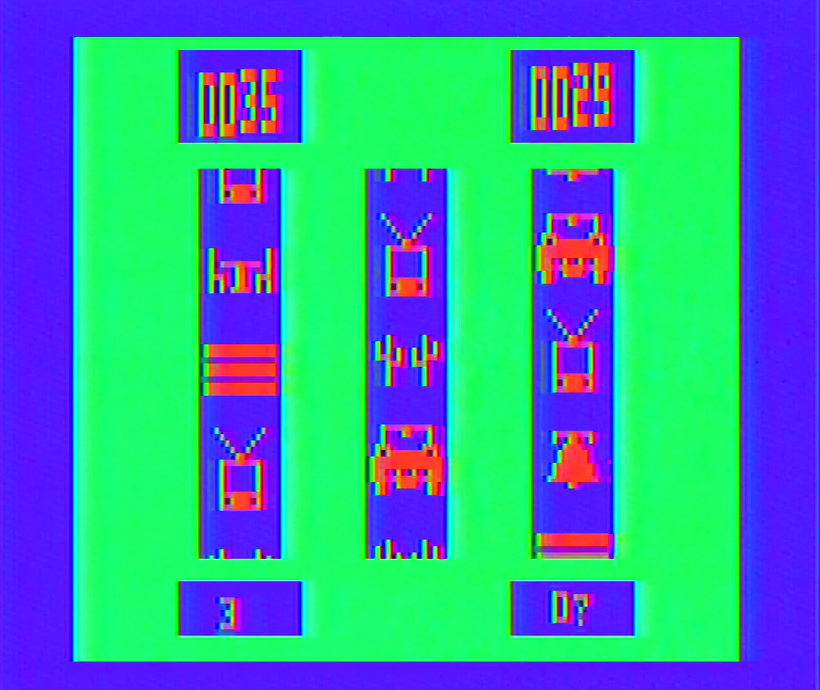
Here we are with the third and final gambling game to be published on the VCS during its commercial life. Unlike Blackjack and Casino, Slot Machine trades in card games in favor of a simulation of, as the name suggests, a slot machine. In this respect it succeeds in producing a perfectly accurate take on slots, but there’s not a whole lot else to it.
Slot machines and video games actually have a bit of a history dating back to the mainframe computer era. The earliest known slot machine video game was Simulation of a One Armed Bandit, written by Dick Conner for the IBM 1620 in 1962 and included in the official software catalog. This version would print out a three-character combination of six symbols using a pseudorandom number generator, following a bet of up to 90 cents a spin. The next known program was One Armed Bandit, written for the DEC PDP-8 computer in 1970 by Larry Owens and James Ward and distributed by the DECUS program library, which gives you 15 silver dollars to try and make a jackpot of lemons, pears, bars, cherries or bells. Another version named Slots written by Fred Mirabelle and Bob Harper was popularized by David Ahl’s 101 Basic Computer Games book in 1973.
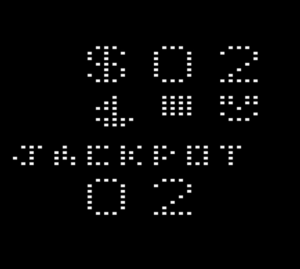
And Joyce Weisbecker wrote her own slot machine game, called Jackpot, for her father Joe’s prototype FRED microcomputer that he was then working on with other RCA engineers in 1974; Weisbecker notes that while she had written little programs on the FRED before this point, Jackpot was among her earliest “games” and was one that the FRED team promoted as a playable game internally at RCA. According to Weisbecker, the game “broke the bank” if you won more than $50, something she was able to demonstrate repeatedly for her mother and sister; her father and FRED’s original designer, Joe Weisbecker, could not figure out how she could do it so consistently and assumed she had worked in some specific timing of stopping the wheels to win repeatedly; she remarked that while she wish she had, as in actually the wheels just all spin separately.
The first full-on video slot machine was also developed in 1975 by the Fortune Coin Company, though players reportedly were not happy with it replacing physical wheels with a digital display. In this regard, this VCS game is less a strange outlier and more of another data point in a continuum of software.
Slot Machine developer David Crane wrote this game specifically for his mother. She enjoyed playing slots, but Crane said she suffered from arthritis in her legs and would have to retire to an easy chair to put her legs up at the end of a normal day. He set her up with a VCS and wrote the Slot Machine game to help her pass the time until her leg pain subsided in one of the sweetest instances of filial piety I think you’d find at Atari.
Crane said he based the game off of the “20 Stop Liberty Bell” machines that were the standard variety of slots game since their invention in 1895 by Charles Fey. What this means is that each “wheel” on the machine has 20 stopping locations and stops after a completely random period of spinning, key factors Crane brought over to his game cart. As he notes, the results of each spin are entirely random, which means that much like an actual slot machine you’ll be hard-pressed to actually win more money than you came in with.
 So with random spins, what does the player actually do in this game? Well, you insert coins. Half the game types on the cart will only pay off on a matching set of images in the center line; the more you bet, the bigger your payoff is if those three symbols line up. The other four game modes allow for up to five pay lines, with additional coins being inserted giving players the ability to win off of the upper, lower, or diagonal lines as well. Both of these variants come in one- and two-player varieties, and players can also choose between a “jackpot” machine that pays out on a trio of bars or cars, or a “payoff” machine that pays out differing amounts based on what images line up. Difficulty switches do absolutely nothing in Slot Machine.
So with random spins, what does the player actually do in this game? Well, you insert coins. Half the game types on the cart will only pay off on a matching set of images in the center line; the more you bet, the bigger your payoff is if those three symbols line up. The other four game modes allow for up to five pay lines, with additional coins being inserted giving players the ability to win off of the upper, lower, or diagonal lines as well. Both of these variants come in one- and two-player varieties, and players can also choose between a “jackpot” machine that pays out on a trio of bars or cars, or a “payoff” machine that pays out differing amounts based on what images line up. Difficulty switches do absolutely nothing in Slot Machine.
Finally, the numbers above the wheels indicate what game type, the number of players and number of pay lines while going through the menu. Once you start the game, these change to indicate how much money players have left, while the numbers below the wheels indicate how much money has been bet. Each push of the controller button adds a coin; pulling back on the joystick pulls the “arm” of the slot machine and sets the wheels in motion, and where they land is anybody’s guess.
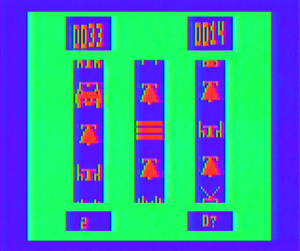 If these wheel images look familiar, it’s because a number of them were also used in the Hunt n Score game that came out in the fall of 1978. David Crane indicated to me that this Slot Machine game was the actual origin of these sprites, which he created. According to Crane, typically Atari game designers made their own game art by coloring squares in on graph paper until it looked like whatever object they were trying to convey, but his boss felt that actual artists could do better. A few graphic designers from the marketing department offered their services and Crane asked them to create images that you’d see in a slot machine, noting that they only had 16 pixels to work within and one color. They quickly gave up and went back to working on game manual and box art, leaving Crane to go back to doing it all the usual way, though he noted with his experience at that point he was able to create recognizable cacti, cars, bells and more. As he puts it, for his games he would experiment with objects until it looked good in the resolution he had to work within, and then it’d find a place in the game.
If these wheel images look familiar, it’s because a number of them were also used in the Hunt n Score game that came out in the fall of 1978. David Crane indicated to me that this Slot Machine game was the actual origin of these sprites, which he created. According to Crane, typically Atari game designers made their own game art by coloring squares in on graph paper until it looked like whatever object they were trying to convey, but his boss felt that actual artists could do better. A few graphic designers from the marketing department offered their services and Crane asked them to create images that you’d see in a slot machine, noting that they only had 16 pixels to work within and one color. They quickly gave up and went back to working on game manual and box art, leaving Crane to go back to doing it all the usual way, though he noted with his experience at that point he was able to create recognizable cacti, cars, bells and more. As he puts it, for his games he would experiment with objects until it looked good in the resolution he had to work within, and then it’d find a place in the game.
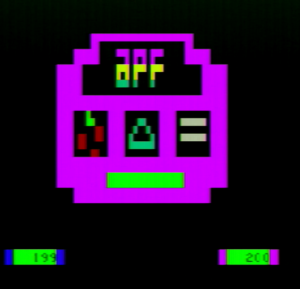
Crane’s work did pay off. If you like slot simulators, the VCS features one of the best of its day. Formal slot machine games came out on the APF MP1000 in 1979, and the Magnavox Odyssey2 and the Channel F in 1980. One thing that is immediately obvious seeing these different games in action is how good Crane’s spritework is for the actual wheel objects compared to every other platform’s. The Odyssey2 predominantly uses its built-in character set with only a couple monochrome cherries and citrus fruits, and while the MP1000 and Channel F had multicolor objects they’re decidedly more abstract than those in Atari’s game. One nice touch in the Channel F and Odyssey2 games is that they show the wheels “spinning,” and while the Odyssey2 doesn’t have the nice slot machine graphic on screen that the Channel F does, it does feature the same five-line payoff as the VCS game. The MP1000 is the real weak link here, without the nice visuals or additional lines.
I’d also like to make mention that slot machines were a popular choice for home developers using the Bally Professional Arcade BASIC cart to make their games, with more than 13 distinct programs being published as a code listing or sold on cassette between 1979 and 1987. These early indie developers did interesting stuff with limited hardware, and it’s certainly worth highlighting their efforts, even showcasing impressive animation and sound effects for the meager amount of memory and the speed of BASIC code on the hardware.
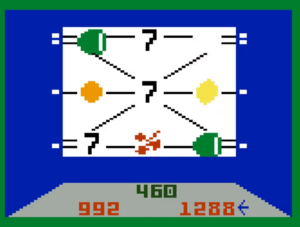
Surprisingly given that it came packed in with the gambling-focused Las Vegas Poker & Blackjack, the Mattel Intellivision never saw its own slot machine program at retail. This wasn’t for a lack of trying, however. Las Vegas Roulette, published around November 1980, was originally intended to include a second slot machine program on the cartridge during development, known at the time as Vegas II. Atariage user Decle managed to find a prototype of Vegas II on a Technology Associates PDP-11 data cassette, and here Las Vegas Roulette was paired with Slots, a slot machine program – albeit a version missing a cherry in the third reel due to the hardware limiting sprites to 8 on screen at a time. Evidently this was never sorted out due to the game size: Intellivision cartridges in 1980 maxed out at 4 kilobytes, with the released version of Las Vegas Roulette landing at about 3.2k; Vegas II in contrast is about 3.9k with its in-development graphics and play elements. There are some key differences in the released version of Roulette and this prototype version that shed some light as to why Slots was cut; in the prototype, the roulette wheel spins constantly here, the animations are harder to parse, and betting is more complicated and tedious, though the keypad is repurposed to shortcut to specific kinds of bets. It’s likely that this was the game as original Las Vegas Roulette programmer Walter Bright had developed it, or at least an in-progress beta while he was working on it (the game was later finalized and completed by John Brooks). The anonymous but seemingly knowledgeable user Walter Ives on Atariage commented that Roulette’s Vegas II version had placeholder betting elements and wheel graphics that had to be reworked at the cost of cartridge space, while Slots still needed an arm and that ninth graphical element, adding that ultimately one of the games had to be cut for space and it ended up being Slots. Slots did end up being used for TV POWWW, a television game show where players would call in and yell “POW” into a phone line to activate a button press, and appears in much better shape in the surviving video clips online. Bright remembered nothing about Slots, so this may have been a project specific to Brooks.
Like fellow 1979 release Miniature Golf, Slot Machine was unceremoniously discontinued by Atari fairly early on, seemingly dropping the game in June 1980 from its lineup alongside 1977 release Star Ship. Distribution of such a limited game never seemed that great – even at its release one can find store ads noting the game was only available on request. It’s really such a slim offering that Atari Corporation didn’t even bring it back at all in the late 80s – and even Star Ship got 26 new copies published in that era. What Slot Machine does, it does very well – there was just never much of a market for it.
Slot Machine does wrap up Atari’s first steps towards releasing new games year-round. These games actually provide a capper for an entire era of Atari game development. For starters, this is David Crane’s final game at Atari we’ll look at – he and fellow developers Alan Miller and Bob Whitehead – joined shortly afterwards by Larry Kaplan – would leave the company in 1979 to form Activision in early 1980. We’ve got one more Bob Whitehead-developed game that will show up this year, but after that you’ll be seeing their names under a different publisher. But beyond staffing changes, the games of fall 1979 mark an inflection point towards an increasing sophistication and complexity. The game sizes are consistently bigger here on out, and developers will use that extra space to truly push the capabilities of the VCS. While 1980 remains the year that the VCS – and the nascent home video game industry as a whole – really begins to hit its stride, the rest of 1979 will truly be setting the console up to become the icon its known as today. Slot Machine is an awfully small stop on that path, but it’s kind of nice to take in the detailed object visuals and basic gameplay before entering a period of technical and critical marvels.
Sources:
David Crane, correspondence with the author, August 17 2017
Joyce Weisbecker, interview with the author, June 5 2021
Catalog of Programs for IBM Data Processing Systems, April 1962
DECUS Program Library: One-Armed Bandit, April 1, 1970
Joe Weisbecker papers, Hagley Museum & Library
The Sarnoff Collection, The College of New Jersey
Atari History Timelines, Michael Current
Las Vegas Roulette, Blueskyrangers.com
Walter Bright, correspondence with the author, May 30-June 7, 2024
Prototype of Las Vegas Roulette and Slots Discovered, Atariage.com
Las Vegas Slots and TV POWWWW, Atariage.com
Release date sources:
Slot Machine (Atari VCS), March 1979 – Source: New York Daily News, March 22 1979; Philadelphia Inquirer, April 8 1979;
Casino I: Roulette/Keno/Slots (MP1000), November 1979 – Source: Janesville Gazette, November 21 1979
Slot Machine (Channel F), Aug. 26 1980 – Source: Zircon press release announcing four new games now available
Casino Slot Machine! (Odyssey2), August 1980 – Source: Daily Herald Suburban Chicago, August 8 1980; Santa Ana Orange County Register, October 16 1980
